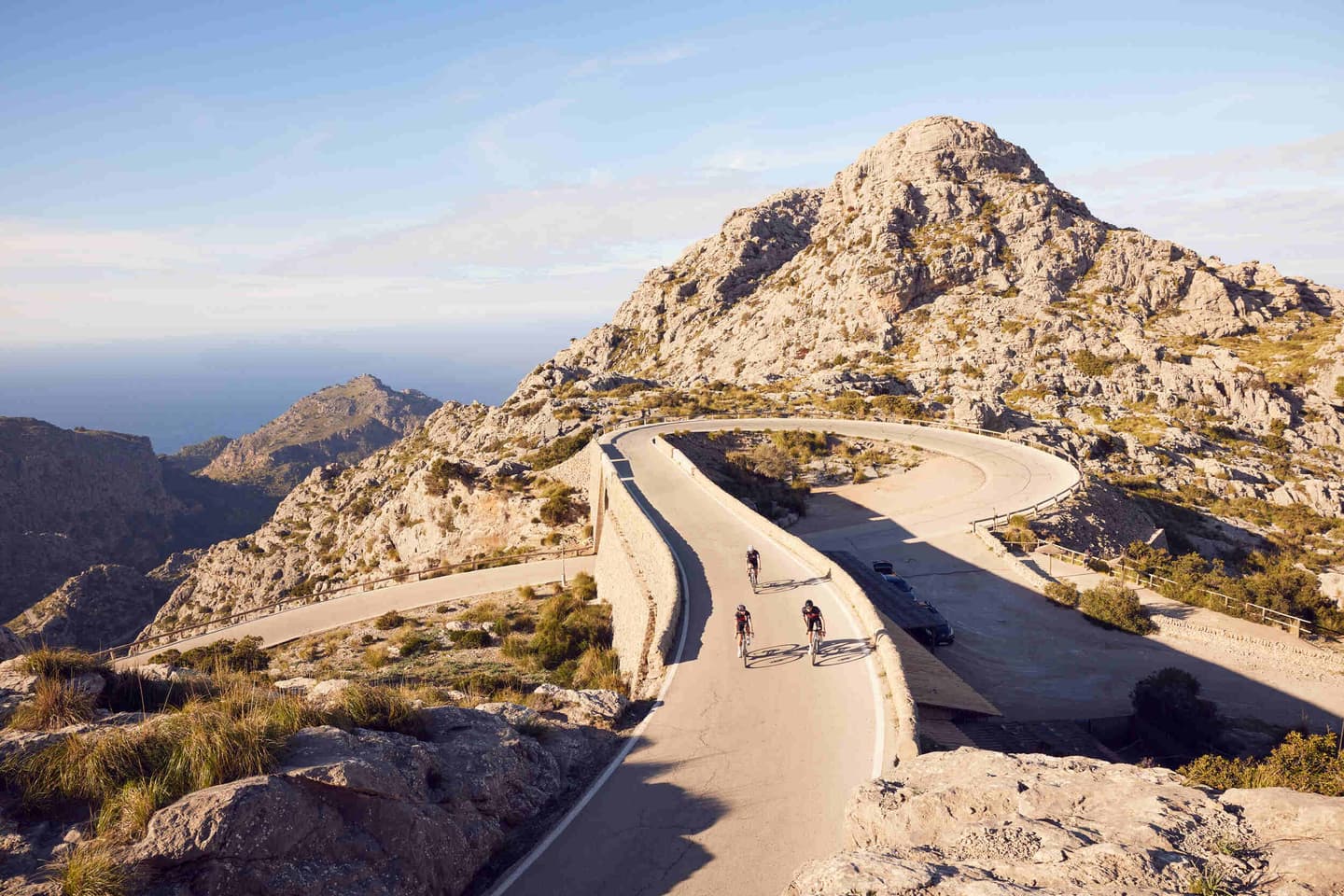

Cycling Sa Calobra in Mallorca
Riding The Stunning Bends Of Sa Calobra
When you dream about your next cycling holiday in Europe, no doubt cycling Sa Calobra in Mallorca will be near the top of your list. It’s just a short flight from the UK making it an easy getaway. It has almost perfect road and weather conditions for cycling most of the year as well as a rich dose of culture, heritage and gastronomy. This gorgeous Mediterranean island makes for the perfect road cycling trip.
For road cycling enthusiasts, there is one climb that stands out as iconic on any cycling holiday to Mallorca - Sa Calobra. Made famous almost a decade ago by Team Sky, the Sa Calobra climb is located in the Tramuntana mountains. It features almost endless picturesque switchbacks and a rocky moon-like landscape overlooking the Mediterranean sea. It’s quite remote, you can only reach the port by boat or by descending Sa Calobra, but that makes it all the more special.
Make An Enquiry
We are the cycling holiday experts.
Whether you're a keen road cyclist, enjoy riding an e-bike or hybrid bike, or want to get your family more active, we have the perfect cycling holiday for you.
What's The Climb Like?
Despite the abundance of climbs on the island, cycling Sa Calobra in Mallorca is reason enough to visit the island. Such reputation has been established over time thanks to the bird’s eye images of Sa Calobra’s trademark hairpin turns. The hairpins are particularly impressive towards the top of the climb, mimicking the silhouette of a grey snake resting in harmony over sharp rock formations.**
The starting point of Sa Calobra climb is its namesake village nestled among monumental cliffs edging the pristine waters of the Northern Mallorca coast. There is no other road to access the climb, but the climb itself. That makes Sa Calobra a route that you will have to descend before you get to ride it uphill for the first time (unless you arrive at the starting point by boat). It also involves a substantial dose of climbing before you even get to it. Whether you ride from Pollensa via the Coll de Sa Batalla (10 Kilometres at 5% average) or from Soller via Puig Major climb (14 kilometres at 6%) you are set for a big day in the saddle.
The Port To Sa Brexta
The road kicks off with the easiest of gradients, slowly making its way up a beautiful valley enclosed between vertical limestone walls. Don’t get fooled by these initial ramps and keep a pace that you can sustain for at least an hour as the ramps will get sharper further ahead.
After 2.5 kilometres you’ll find one of the main highlights of this beautiful climb, the rocks seem to swallow the narrow strip of tarmac as you make your way across Sa Bretxa, an impressive natural arc with just enough space for one bus to pass through.
The Hairpins
It’s not until kilometre 6 that the real hairpins kick in, unleashing a dizzying number of twists and turns over the increasingly exposed terrain.
This part of the climb surely is among the most scenic segments of road to ride a bicycle, anywhere in Europe. The scenery and the viewpoint changes every few meters and the imposing calm of the Mediterranean sea provides a magnificent backdrop.
The Final Push
If you chose to push it hard up to this point, you better have saved something in the tank for the last 3 kilometres since they will be the toughest of the climb. The hardest section of the climb is actually between kilometres 7 and 8, with hairpins coming thick and fast, and the average gradient increasing. That, added to the fatigue accumulated over the whole climb, will make you struggle to reach the top if you haven’t paced yourself from the beginning.
The very last hairpin it’s also the most iconic - Nus the Sa Corbata (literally meaning “Tie knot”). It’s the famous photo of Sa Calobra and features a 270-degree turn with the road bending over itself. From there it’s just a 500 meters sprint up to the top of the climb.
Key Statistics
Length: 9.5 kilometres
Average Gradient: 7%
Toughest Gradient: 12
What does this mean in terms of duration? Well, for a pro cyclist it is a sub-30 minutes effort. A well-trained amateur can knock it off in just 45 minutes putting down a decent 3.5 Watts per Kilo. Assuming you are on a cycling holiday and also want to enjoy the astounding scenery, you will be in for a solid hour of climbing.
The road features 26 hairpin bends and the gradients are very steady at around 7%, maxing out at 12% for short stretches of road. A standard compact crankset with a 34T inner ring and a 28T sprocket at the back will suffice for any “weekend warrior” to complete Sa Calobra without grinding it out too much.
Ride Sa Calobra on These Holidays
Top Tips
The narrow road to the remote Sa Calobra village is a rather busy tourist bus route (especially in the peak holiday season). For that reason, you should aim to ride Sa Calobra no later than 9 am. The lack of shade in some parts of the climb also makes riding early a good idea in the hot months of Spring and Summer when temperatures can easily reach over 30 degrees. It rarely rains in Sa Calobra but another weather factor that can play a big part in your ride is the wind, especially towards the end of the climb.
You will be sharing this narrow twisty road with traffic and sometimes inexperienced cyclists so be really careful on your descent.
Every Saturday morning, a local club rides up Sa Calobra which is a good opportunity to set your PB up the climb if you can hang on to a wheel!
If you happen to be cycling in Mallorca for just a couple of days, we recommend hiring a bike. You will be able to hire anything from a standard carbon road bike, to a full carbon bike with DI2 electronic gearing and disc brakes.
There are also plenty of accommodation options in Port Pollensa and we can help with providing you anything from budget to luxury and boutique to resort.
Where To Refuel With Coffee & Cake
Close to the top of Coll de Sa Batalla there is a famous meeting point for cyclists on their way to ride Sa Calobra. There is a restaurant just 10 kilometres from the summit of the climb, next to the petrol station, offering a wide variety of Spanish toasts, sandwiches, and cakes. There’s even a rack with tools to fix the odd mechanical and check your tyre pressure.
Following the same road, and 2 kilometres before the crest of Sa Calobra, you will find the last place to refuel before the descent. The small Cafe Escorca is hidden between the tallest peaks of the Tramuntana mountains and nearby a beautiful ancient aqueduct. Flocks of roadies come here to drink a coffee, eat a snack, or just pose for a customary picture.
At the bottom of the climb, in Sa Calobra village you’ll also find a few overpriced restaurants where you can buy a coffee or a soft drink. With the only exception of a small cafe located right at the 270-degree bend (which only opens in the peak tourist summer season), there aren’t any places to refuel so be sure to be equipped for your climb.
Top Tips For Cycling Sa Calobra
Make sure you have planned your cycling route. You can't access Sa Calobra without a lot of climbing so make sure you are well prepared. It's all about timing. If you arrive too late in the day, you will be sharing the road with busses and other vehicles. Make sure you arrive nice and early.
Preparation is key not just for your cycling route. You also need to prepare for the ascent. As you climb higher out of the valley, you will be onto exposed terrain. Take a windproof jacket or arm warmers as it can get breezy!
Most riders who have cycled Sa Calobra will say the same thing. Be extra careful on your descent. The corners are sharp, steep and shady. Any vehicles or bikes coming up the climb need a wide berth so unless your Chris Froome, it's best to have your hands hovering over the brakes, especially towards the bottom of the climb.
Fill up your water bottles at the bottom. There are no stops between the port and the summit.
Sa Calobra Weather
The summer is very hot in Mallorca. The climb is completely exposed at the top so you want to be summiting no later than mid morning in the middle of summer.
Riding in the shoulder seasons of Spring and Summer are perfect if you want to tackle Sa Calobra. You will enjoy cool breezes and temperatures in the mid 20s.
The Best Cycling Climbs In Mallorca
If you enjoyed reading about the Sa Calobra, check out these other great cycling climbs in Mallorca.
Read about Coll de sa Batalla
Read about Puig Major
Read about Port De Valldemossa
Read about Coll de Randa
Read about Coll d'Honor
Read about Coll de Soller
Read about Coll de Femenia
Mallorca Cycling Routes
For more information about other exciting cycling experiences we offer, visit our Mallorca cycling holidays page.
Make An Enquiry
We are the cycling holiday experts.
Whether you're a keen road cyclist, enjoy riding an e-bike or hybrid bike, or want to get your family more active, we have the perfect cycling holiday for you.





